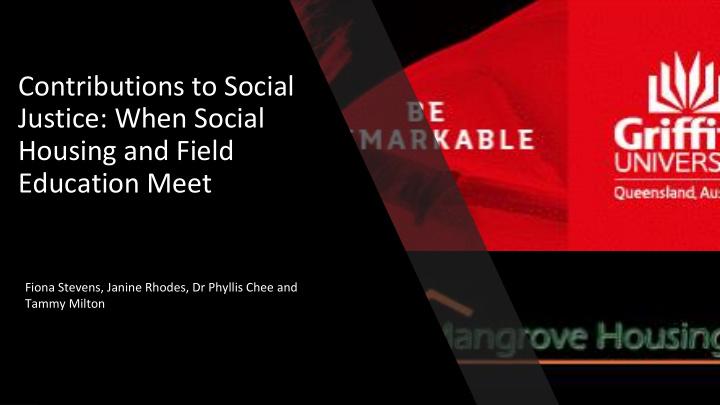



Contributions to Social Justice: When Social Housing and Field Education Meet Fiona Stevens, Janine Rhodes, Dr Phyllis Chee and Tammy Milton
Introduction • Field Education – cornerstone in social work placements • Unprecedented demand for placements = increasing student numbers • Changes in Program structures • Pressure in the field = demand vs funding • Response = collaborative partnerships
How did this happen? • Serendipity! • Agency with multiple projects & University requiring multiple placements • Mangrove = open to “give it a go” and “why not?” rather that “why would we?” • Staff to support and absorb students • Confident agency could manage the challenge • Students could support each other – negotiate projects based on own capabilities
Initial Observations • Students contribution to agency = • Increase in service delivery • Project implementation • Meeting key performance indicators • Engagement with other staff – questioning, reflecting, processing
Integrating students in the agency: • Creating a positive/shared supervision model • Staff providing support/direction with students • Orientation process = positive outcomes • Students confidence established in this process • Students’ project presentation = shift in staff’s attitude
In practice... • Trust in the relationship • Continual engagement – checking in • Goodwill with parties • Matching student goals to learning opportunities • It’s not perfect!
Critique of our process: • Organic process vs evidence-based approach • How is this different from any other placement arrangement? • Developed agency confidence • Integration of students • Increasing momentum for students • Identified process for “matching” students
Limitations – research team reflection: • Personal experiences of the team - may not work elsewhere • Based in relationship - time/resources can limit the approach
Discussion & Implications: • Identified extension to supervisors training • Compatibility & availability with staff and students • Resource intensive (model)
Conclusion ● Be aware of mutual benefits (field education placements can support agency’s practice and vice versa) ● Focus on relationships and building trust ● Select suitable students (university and agency) ● Allocate resources appropriately ● Ongoing review of placement process (university and agency)
Recommend
More recommend